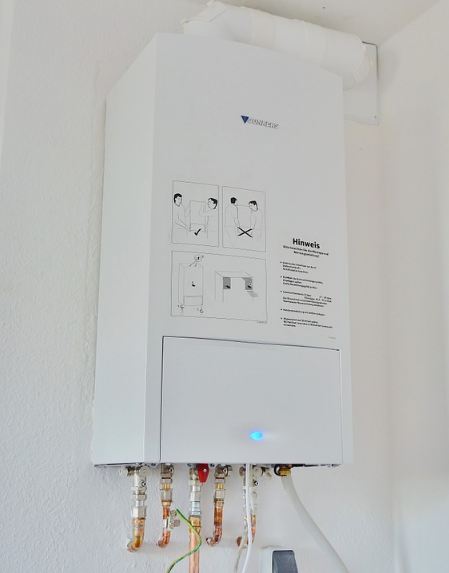A tankless water heater is also known as a demand-type or instantaneous water heater. It provides hot water only when needed; thus, it does not produce the standby energy losses associated with storage water heaters. This means you can save your money!
How tankless water heater works
The water is directly heated in a tankless water heater. As you turn on the hot water tap, the cold water travels through a pipe into the unit, and it will be automatically heated without you waiting any longer. A tankless water heater, therefore, delivers a constant supply of hot water. Yet, its output also limits the flow rate.
A tankless water heater typically provides 2-5 gallons of hot water in a minute. Compared to the electric units, a gas-fired tankless water heater produces higher flow rates. Even the largest gas-fired model sometimes cannot supply enough hot water simultaneously, especially in large households.
Multiple simultaneous tasks requiring the use of hot water can be resolved by having two or more tankless water heaters installed connected in parallel. You can either install separate tankless water heaters for appliances — such as a clothes washer or dishwater — that use a lot of hot water in your home.
What’s good about tankless water heater is the space you can save as you don’t need to install a tank in your area. You save time whenever you need a lot of hot water supply.
Other applications for demand water heaters include remote bathrooms or hot tubs, booster for appliances, dishwashers or clothes washers, booster for a solar water heating system.
Advantages and Disadvantages of having a tankless water heater
- Tankless water heaters are also called “on-demand” units, or instant hot water heaters that use 30 to 50 percent less energy than units with tanks. Savings can be about $100 or more per year, depending on water usage.
- Your consumption only starts the moment you turn on the faucet.
- This either operates on natural gas or propane.
- The main advantage is eliminating the extra cost of keeping 40 to 50 gallons of hot water. It offers a continuous supply of hot water, which is ideal for filling a big hot tub or a whirlpool.
- This is more compact than a standard water heater and can be mounted on a wall.
To help you decide, here’s what you need to know about Tankless Water Heater
For homes or establishments that utilize 41 gallons or less of hot water daily, demand water heaters can be 24%–34% more energy-efficient than conventional storage-tank water heaters.
In homes where consumption can reach up to 86 gallons each day, a tankless water heater can be 8%–14% more energy efficient. If you install a demand water heater at each hot water outlet, you can achieve even greater energy savings of 27%–50%.
Some may be hesitant to try using a tankless water heater since its initial cost is greater than that of a conventional storage water heater. However, it will be durable and long-lasting that can have lower operating and energy costs. It could even offset its higher purchase price.
Tankless water heaters can last for over 20 years. If a particular part deteriorates, it can easily be replaced and fixed that extends its life by many more years. In contrast, conventional water heaters last 10–15 years.
The use of tankless water heaters can avoid the standby heat losses associated with storage water heaters. However, although with gas-fired tankless water heaters, there are higher flow rates than electric ones, if they have a constantly burning pilot light, they can waste energy. In this case, it would offset the elimination of standby energy losses compared to a storage water heater. In a gas-fired storage water heater, the pilot light heats the water in the tank, so the energy isn’t wasted.
There is a varying cost of operating a pilot light in a tankless water heater based on its model. You may ask the manufacturer how much gas the pilot light uses for the model you’re considering. If you go for a model that has a standing pilot light, you can save energy by always turning it off when it’s not in use. However, it is advisable to use a model with an intermittent ignition device (IID) instead of a standing pilot light. Similar to some gas kitchen ranges and ovens, the device resembles the spark ignition.
Related Links:
https://www.familyhandyman.com/article/the-pros-and-cons-of-tankless-water-heaters/
https://www.thisoldhouse.com/plumbing/21019184/read-this-before-you-buy-a-tankless-water-heater
